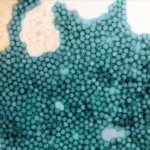Link to Pubmed [PMID] – 19412342
PLoS Pathog. 2009 May;5(5):e1000412
Ten outbreaks of poliomyelitis caused by pathogenic circulating vaccine-derived polioviruses (cVDPVs) have recently been reported in different regions of the world. Two of these outbreaks occurred in Madagascar. Most cVDPVs were recombinants of mutated poliovaccine strains and other unidentified enteroviruses of species C. We previously reported that a type 2 cVDPV isolated during an outbreak in Madagascar was co-circulating with coxsackieviruses A17 (CA17) and that sequences in the 3′ half of the cVDPV and CA17 genomes were related. The goal of this study was to investigate whether these CA17 isolates can act as recombination partners of poliovirus and subsequently to evaluate the major effects of recombination events on the phenotype of the recombinants. We first cloned the infectious cDNA of a Madagascar CA17 isolate. We then generated recombinant constructs combining the genetic material of this CA17 isolate with that of the type 2 vaccine strain and that of the type 2 cVDPV. Our results showed that poliovirus/CA17 recombinants are viable. The recombinant in which the 3′ half of the vaccine strain genome had been replaced by that of the CA17 genome yielded larger plaques and was less temperature sensitive than its parental strains. The virus in which the 3′ portion of the cVDPV genome was replaced by the 3′ half of the CA17 genome was almost as neurovirulent as the cVDPV in transgenic mice expressing the poliovirus cellular receptor gene. The co-circulation in children and genetic recombination of viruses, differing in their pathogenicity for humans and in certain other biological properties such as receptor usage, can lead to the generation of pathogenic recombinants, thus constituting an interesting model of viral evolution and emergence.


